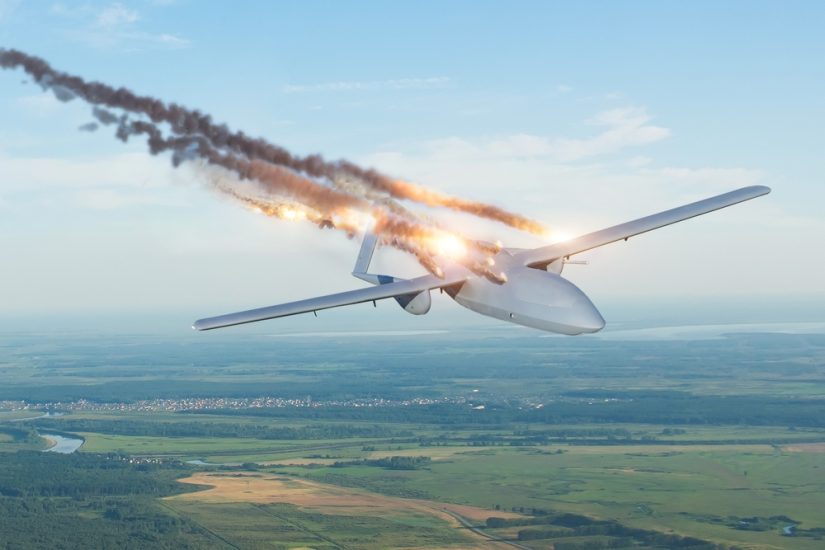By Philip Butterworth-Hayes
The evolution of drone and counter-drone warfare in Ukraine is changing the way armies, air forces and navies need to prepare for the next conflict. Unmanned Airspace has reviewed recent stories in defence and technology journals covering this conflict – as well as informed social media content providers – and has identified some of the new trends in drone warfare and C-UAS measured which have emerged just over the past few weeks alone which we think are particularly significant. From the vast numbers of drones being downed by friendly fire to the emergence of AI in swarming attacks involving drones, cruise and ballistic missiles.
“More than two-thirds of the Russian tanks that Ukraine’s military has destroyed in recent months have been taken out using first-person-view (FPV) drones, a NATO official told Foreign Policy, an increasing sign of Kyiv’s reliance on the unpiloted aircraft as it awaits more artillery ammunition from the United States and other Western countries.”
https://foreignpolicy.com/2024/04/09/drones-russia-tanks-ukraine-war-fpv-artillery/
“Lt. Col. Michael Pruden, branch head at Marine Air Command and Control Systems Integration, Combat Development Directorate, said before deploying any kind of counter-UAS capabilities, “First, I need to be able to go ahead and detect that UAS, and I need to identify it, then I need to go ahead and target it, and I need to destroy it.”….Pruden said 40 percent of drones knocked out in Israel were from friendly fire.
“Ukraine has sidelined U.S.-provided Abrams M1A1 battle tanks for now in its fight against Russia, in part because Russian drone warfare has made it too difficult for them to operate without detection or coming under attack, two U.S. military officials told The Associated Press.”
“A new type of long-range Ukrainian FPV drone is destroying Russian mobile air defense systems. The greater reach of this type of weapon brings many new targets into range, and the Ukrainians are taking advantage by knocking out expensive equipment before the Russians can move it to safety. The new weapons have been dubbed ‘Ukrolancets’ as they fulfill a similar role to Russia’s much-feared Lancet kamikaze drones. But they are likely to appear in much larger numbers.”
https://www.forbes.com/sites/davidhambling/2024/04/10/ukrolancet-drones-blitz-russian-air-defenses/
“FPV drones arrive in yet another war. Myanmar rebels, soon after using kamikaze UAVs, have begun using FPV drones.”
https://twitter.com/clashreport/status/1786284156403552306?s=46&t=7FyfjkHs4sR-xcgNzg9Igg
“With the probable loss of the missile patrol ship Sergey Kotov on March 5 in coastal waters near Feodosia, occupied Crimea, the Russian Black Sea fleet has lost three vessels in similar drone swarm attacks (and many more in cruise missile and aerial drone strikes.) While many have proclaimed the drone campaign a revolution in naval warfare, the drones in fact continue a time-honored tactic of crewed small combatants working as a team to destroy a single, larger, and more capable opponent. ”
“Russian T-90M Proryv tanks were equipped with factory canopies to protect against drones, this has not yet been officially announced. The first tanks were spotted at one of the training grounds, where the gunner-operator of one of the combat vehicles told his impressions of the tank. A protective canopy from the drone covers the top of the entire tank turret, and it also has hatches for loading the crew. The protection looks pretty good and is strikingly different from the homemade structures that the crews themselves previously installed on tanks.”
https://www.youtube.com/watch?v=3zf4FmuIAPg
“According to Russian media, analysts specializing in unmanned aviation suggest that the Russian occupation army might soon adopt a new tactic involving the use of “loitering munitions or kamikaze drones that can interact with each other on the battlefield”. The report indicates that while specific details about these plans remain undisclosed, there is an expectation for the deployment of groups of loitering munitions operating in coordination, essentially forming a swarm. While this concept isn’t novel, it underscores ongoing efforts to enhance these capabilities.”
https://en.defence-ua.com/analysis/russian_military_considers_drone_swarm_tactics_for_war_in_ukraine-9517.html
(Image:Shutterstock)




